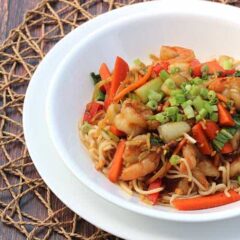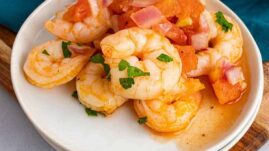This post may contain affiliate links. Please read our disclosure.
If you’re craving Asian noodle dishes, you have to try my shiritaki noodles with shrimp stir-fry! It’s low carb, easy to make, and oh-so delicious.

Have you tried cooking with shirataki noodles yet?
These almost-zero-carb noodles are made from the soluble fiber found in the root of the konjac plant. When prepared correctly, the texture is very similar to rice noodles, which makes them great for Asian dishes.
In fact, I love making shirataki noodles with shrimp stir-fry! The medley of shrimp, bok choy, broccoli slaw, and carrots over the low-carb noodles is so satisfying.
If you’ve been craving Asian noodle dishes but don’t want the blood glucose spike that comes with regular noodles, you definitely have to give this recipe a try.
How to make shirataki noodles with shrimp stir-fry
This recipe comes together in just a few steps. We’ll make the sauce, prep the noodles, then cook it all up!
Step 1: To make the sauce, whisk together the water, hoisin sauce, tamari/soy sauce, and Sriracha in a small bowl. Stir in the garlic and ginger, then set aside.
Step 2: To prep the noodles, start by rinsing and draining them in a small mesh strainer.
Step 3: Bring a large saucepan of water to a boil over high heat, then add the noodles and cook for 3 minutes. Drain and rinse again.
Step 4: In the same saucepan or a medium nonstick skillet, heat the noodles in the dry pan, stirring frequently, until the noodles are no longer moist.
Step 5: To cook the stir fry, start by heating 1 tablespoon of oil in a wok or very large skillet over medium-high heat.
Step 6: Add half of the shrimp and cook until they just turn opaque, about 2 minutes, then remove to a plate lined with paper towels.
Step 7: Repeat with the remaining shrimp.
Step 8: Add the remaining 1 tablespoon of oil to the wok, then add the carrots and stir-fry for about a minute.
Step 9: Add the red bell peppers and stir-fry for about a minute.
Step 10: Add the white parts of the bok choy and scallions and stir-fry for about a minute.
Step 11: Add the broccoli slaw and green parts of the bok choy and stir-fry for about a minute.
Step 12: Return the shrimp to the pan, add the sauce, and cook for a minute or two until the sauce thickens and the shrimp is hot again.
Step 13: Mix in the noodles and garnish with the green parts of the scallions.
Your stir-fry is ready to enjoy!
Prepping the noodles
When you cook with shirataki products, the prep step is extremely important. You do not want to skip it!
When you first open the bag of noodles, you’re going to notice a strong smell. The point of the prep steps is to totally get rid of that smell.
So anytime you’re cooking with shirataki, be sure to rinse, boil, drain, then pan fry. It doesn’t take long, and it makes all the difference.
I wanted to emphasize this because I once skipped this process and regretted it. The noodles were so bad that I never would have bought them again if I didn’t know better!
Lowering the sodium
Most of the sodium in this recipe comes from the hoisin sauce, soy sauce, and sriracha sauce as well as the shrimp.
To lower the sodium, you can cut back on the sauces and use a bit of low-sodium chicken or vegetable stock instead.
You could also use less shrimp and replace it with more vegetables. Just keep in mind that this will increase the carbs and decrease the protein in this dish.
Choosing your protein
I chose to use shrimp in this recipe because it’s quick and easy to cook. One pound of shrimp cooks up in less than 5 minutes.
However, if you don’t like shrimp or simply want to use something else, you can definitely swap out the protein!
Chicken would be a great option for lean protein. I could even see sliced beef going well with this recipe.
If you use something other than shrimp, you should cube or slice it into bite-sized pieces. Then, make sure you cook it all the way through when you’re starting the stir-fry steps.
Storage
Leftovers can be stored covered in the refrigerator. Because of the shrimp, you’ll want to make sure you eat the rest of your stir fry within 3 or 4 days.
I recommend reheating this dish slowly in a pan or skillet, stirring frequently, to try to avoid over-cooking the shrimp.
Other delicious low-carb shrimp recipes
I love finding tasty dishes that are low in carbs and will have less of an impact on my blood sugar. Here are some of my favorites:
You can also check out my roundup of low-carb seafood recipes for more inspiration.
When you’ve tried this stir fry, please don’t forget to let me know how you liked it and rate the recipe in the comments below!
Shirataki Noodles with Shrimp Stir-Fry

Ingredients
SAUCE
- 3 tablespoons water
- 1 tablespoons hoisin sauce
- 2 tablespoons low-sodium tamari , (or soy sauce)
- 2 teaspoons Sriracha sauce
- 1 tablespoon minced garlic
- 2 teaspoons minced ginger
NOODLES
- 1 pound spaghetti-shaped shirataki noodles
STIR-FRY
- 2 tablespoons coconut oil
- 1 pound medium to large fresh or frozen shrimp, (thawed if frozen, peeled and deveined)
- 2 medium carrots, (cut into matchsticks)
- ½ large red bell pepper, (chopped)
- 1 head baby bok choy, (green and white parts chopped separately)
- 3 medium scallions, (green and white parts chopped separately)
- 1 cup broccoli slaw
Instructions
MAKE THE SAUCE
- Whisk together the water, hoisin sauce, tamari/soy sauce, and Sriracha in a small bowl. Stir in the garlic and ginger, then set aside.3 tablespoons water, 1 tablespoons hoisin sauce, 2 tablespoons low-sodium tamari, 2 teaspoons Sriracha sauce, 1 tablespoon minced garlic, 2 teaspoons minced ginger
PREP THE NOODLES
- Rinse and drain the noodles in a small mesh strainer.1 pound spaghetti-shaped shirataki noodles
- Bring a large saucepan of water to a boil over high heat, then add the noodles and cook for 3 minutes. Drain and rinse again.
- In the same saucepan or a medium nonstick skillet, heat the noodles in the dry pan, stirring frequently, until the noodles are no longer moist.
COOK THE STIR-FRY
- Heat 1 tablespoon of oil in a wok or very large skillet over medium-high heat.2 tablespoons coconut oil
- Add half of the shrimp and cook until they just turn opaque, about 2 minutes, then remove to a plate lined with paper towels.1 pound medium to large fresh or frozen shrimp
- Repeat with remaining shrimp.
- Add the remaining 1 tablespoon of oil to the wok, then add the carrots and stir-fry for about a minute.2 medium carrots
- Add the red bell peppers and stir-fry for about a minute.½ large red bell pepper
- Add the white parts of the bok choy and scallions and stir-fry for about a minute.1 head baby bok choy, 3 medium scallions
- Add the broccoli slaw and green parts of the bok choy and stir-fry for about a minute.1 cup broccoli slaw
- Return the shrimp to the pan, add the sauce, and cook for a minute or two until the sauce thickens and the shrimp is hot again.
- Mix in the noodles and garnish with the green parts of the scallions.


